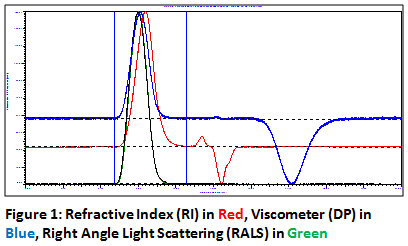
Absolute Molecular Weight Determination
GPC-T couples a GPC separation with a light-scattering (LS) detector for absolute molecular weight determination and a viscometer for determination of polymer shape and radius of hydration (Rh). The use of an LS detector renders calibration standards unnecessary as the measurement is based on the way in which the sample scatters light and not the retention time at which the molecule elutes as compared to standards. GPC-T is frequently used for the analysis of high value polymers used in medical devices and to support regulatory submissions.
With standardized GPC, the chemistry and molecular structure of the calibration standards frequently differs from the chemistry of the polymer of interest. Furthermore, the calibration standards used are linear polymers which can potentially have an adverse effect on the calculated values if the polymer of interest has significant branching. However, GPC-T does not have these limitations – the molecular weight distribution of the polymer of interest is directly measured with the light scattering detectors and is therefore an absolute measure of molecular weight.
As with GPC, in GPC-T, the polymer of interest is fully dissolved in a solvent with subsequent size-based chromatographic separation on a GPC column. Mn, Mw, Mz, and PDI are also provided. The three detectors in GPC-T are Refractive Index (RI), Intrinsic Viscosity (IV), and Light Scattering (Low Angle Light Scattering (LALS) and Right Angle Light Scattering (RALS)). Using the Mark–Houwink equation and IV data, branching characteristics of a polymer can be obtained.
Come to Jordi Labs and determine the absolute molecular weight of your specific sample without the need for structurally equivalent standards!
- Absolute Molecular Weight information for your polymer
- Determination of Mn, Mw, Mz and PDI
- Degree of branching information with Mark–Houwink plot
- Needed for regulatory (FDA, EPA) submissions




